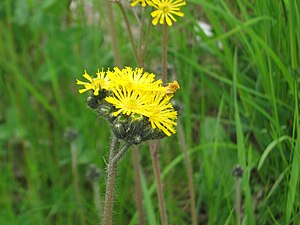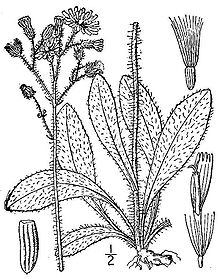Meadow hawkweed
| Meadow hawkweed | ||||||||||||
|---|---|---|---|---|---|---|---|---|---|---|---|---|

Meadow hawkweed ( Hieracium caespitosum ) |
||||||||||||
| Systematics | ||||||||||||
|
||||||||||||
| Scientific name | ||||||||||||
| Hieracium caespitosum | ||||||||||||
| Dumort. |
The meadow hawkweed ( Hieracium caespitosum ) PDSell & C.West , syn .: Pilosella caespitosa (Dumort.) PDSell & C.West is a species of hawkweed ( Hieracium ) in the daisy family (Asteraceae). It is native to large parts of Europe and also occurs wild in parts of North America. Some authors also assign it to the genus Pilosella , which in turn is viewed by other authors as a subgenus of Hieracium .
description
Vegetative characteristics
The Meadow hawkweed is a perennial and perennial , herbaceous plant reached, the plant height of 20 to 75 centimeters. The species forms both above and below ground runners . The upright stems are covered with numerous fine, 1 to more than 3 millimeters long, coarse hairs and have a finely but coarse hairy base.
At the base of the stem there are three to eight, sometimes more basal leaves , while there are no or up to two, occasionally up to five or more leaves on the stem.
The leaf blade is at a length from 3.5 to 18 centimeters and a width from 1.2 to 2 centimeters-oblanceolate to lanceolate with wedge-shaped Spreitenbasis and tapered or round Spreitenspitze. The spreading margins are whole or serrated. Both the underside and the upper side of the leaf are usually covered with numerous 1 to 3 millimeter long, coarse hairs, more rarely the leaves are hairless.
Generative characteristics
The flowering period extends in Central Europe and North America from May to August. The more or less umbel-like or crowded total inflorescence usually contains 5 to 25, occasionally more cup-shaped partial inflorescences. The inflorescence stem is covered with 1 to 2.5 millimeters long fine and rough hair. With a length of 0.75 to 0.9 centimeters, the bell-shaped involucre contains 12 to 18, occasionally more coarse hairy bracts on the underside . The flower heads contain 25 to 50 or more ray florets. The yellow ray florets are 0.8 to 1.2 inches long.
The achenes are columnar with a length of 1.5 to 1.8 millimeters. The pappus consists of 25 to 30 white bristle hairs, which are 4 to 6 millimeters long.
Chromosome number
The number of chromosomes is 2n = 18, 27, 36 or 45.
Occurrence
The meadow hawkweed is native to large parts of Europe ; however, it does not occur in the Mediterranean south ( Iberian Peninsula , Italy ). In the north-western USA , the meadow hawkweed occurs in the wild and is considered an invasive neophyte that grows mainly on disturbed areas and along rivers at altitudes of 10 to 1500 meters.
The meadow hawkweed is an undemanding plant species that also thrives in dry locations. It occurs in plant communities of the order Molinietalia, but also in socially humid societies of the orders Arrhenatheretalia or Nardetalia or the association Mesobromion. In the Allgäu Alps , it rises under the Seifenmoos on the Stuiben in Bavaria up to 1320 m above sea level.
Taxonomy
The first description under the name ( Basionym ) Hieracium caespitosum was made in 1827 by the Belgian botanist Barthélemy Charles Joseph Dumortier in Florula belgica, opera majoris prodromus, auctore ... , p. 62. The new combination Pilosella caespitosa was made in 1967 by Peter Derek Sell and Cyril West in Watsonia , Volume 6, p. 314.
Further synonyms for Pilosella caespitosa ( Dumort. ) PDSell & C.West are: Hieracium pratense Tausch , Pilosella pratensis ( Tausch ) FWSchultz & Sch.Bip. , Hieracium karelicum ( Norrl. ) Norrl. , Hieracium dublanense ( Rehmann ) Czerep. , Hieracium pratense subsp. altaicum ( Nägeli & Peter ) Zahn , Hieracium collinum subsp. dublanense Rehmann , Hieracium rawaruskanum (tooth) Czerep. , Hieracium pratense subsp. sudetorum ( Peter ) Zahn , Pilosella altaica ( Nägeli & Peter ) Schljakov , Hieracium dimorphum Norrl. , Hieracium sudetorum ( Peter ) J.Weiss , Hieracium pratense subsp. ipecense Nägeli & Peter , Hieracium pratense subsp. rawaruskanum tooth , Hieracium leptocaulon ( Nägeli & Peter ) Üksip , Pilosella caespitosa subsp. sudetorum ( Peter ) Soják , Hieracium collinum subsp. altaicum Nägeli & Peter , Pilosella karelica Norrl. , Hieracium pratense subsp. leptocaulon ( Nägeli & Peter ) Zahn , Hieracium collinum subsp. dissolutum Nägeli & Peter , Hieracium pratense subsp. dimorphum ( Norrl. ) H. Lindb. , Pilosella aurantiaca subsp. dimorpha ( Norrl. ex Norrl. ) T. Tyler , Hieracium dissolutum ( Nägeli & Peter ) Üksip , Pilosella leptocaula ( Nägeli & Peter ) Schljakov , Pilosella sudetorum ( Peter ) Dostál , Pilosella rawaruskana ( tooth ) Schljakov , Hieracium collinum subsp. leptocaulon Nägeli & Peter , Pilosella dissoluta ( Nägeli & Peter ) Schljakov , Hieracium caespitosum var. caespitosum , Pilosella dublanensis ( Rehmann ) Schljakov , Hieracium pratense subsp. pratense , Hieracium pratense subsp. dublanense ( Rehmann ) tooth , Hieracium collinum subsp. sudetorum Peter , Hieracium pratense subsp. dissolutum ( Nägeli & Peter ) Zahn , Hieracium pratense subsp. karelicum ( Norrl. ) Zahn , Hieracium altaicum ( Nägeli & Peter ) Üksip , Pilosella caespitosa subsp. dissoluta ( Nägeli & Peter ) Soják , Hieracium caespitosum ( Nägeli & Peter ) Nyár. subsp. caespitosum , Pilosella caespitosa subsp. leptocaula ( Nägeli & Peter ) Soják .
Individual evidence
- ↑ a b Hieracium caespitosum Dumort. In: US National Plant Germplasm System. www.npsweg.ars-grin.gov, accessed on March 21, 2017 (English).
- ↑ a b c Pilosella caespitosa (Dumort.) PD Sell & C. West. In: Global Compositae Checklist. www.compositae.landcareresearch.co.nz, accessed on March 21, 2017 (English).
- ↑ a b c d e John L. Strother: Asteraceae . Hieracium . In: Flora of North America Editorial Committee (Ed.): Flora of North America North of Mexico . Magnoliophyta: Asteridae, part 6: Asteraceae, part 1 (Mutisieae-Anthemideae). Volume 19. Oxford University Press, New York and Oxford 2006, ISBN 0-19-530563-9 , Hieracium (English, Hieracium caespitosum - online - this work is online with the same text.).
- ↑ a b c meadow hawkweed . In: BiolFlor, the database of biological-ecological characteristics of the flora of Germany.
- ↑ a b Erich Oberdorfer : Plant-sociological excursion flora for Germany and neighboring areas . With the collaboration of Angelika Schwabe and Theo Müller. 8th, heavily revised and expanded edition. Eugen Ulmer, Stuttgart (Hohenheim) 2001, ISBN 3-8001-3131-5 , pp. 1001 .
- ↑ meadow hawkweed. In: National Park Service. www.nps.gov, accessed on March 21, 2017 (English).
- ↑ Erhard Dörr, Wolfgang Lippert : Flora of the Allgäu and its surroundings . tape 2 . IHW-Verlag, Eching near Munich 2004, ISBN 3-930167-61-1 , p. 690 .
- ↑ Hieracium caespitosum at Tropicos.org. Missouri Botanical Garden, St. Louis. Retrieved March 21, 2017.
- ↑ Pilosella caespitosa. In: The Euro + Med PlantBase Project. www.bgbm.org, accessed on March 21, 2017 (English).
- ↑ Pilosella caespitosa. In: Cichorieae Portal. www.cichorieae.e-taxonomy.net, accessed on March 21, 2017 (English).
Web links
- Meadow hawkweed. In: FloraWeb.de.
- Meadow hawkweed . In: BiolFlor, the database of biological-ecological characteristics of the flora of Germany.
- Profile and distribution map for Bavaria . In: Botanical Information Hub of Bavaria .
- Hieracium caespitosum Dumort. In: Info Flora , the national data and information center for Swiss flora . Retrieved July 11, 2016.
- Thomas Meyer: Hawkweed data sheet with identification key and photos at Flora-de: Flora von Deutschland (old name of the website: Flowers in Swabia )
